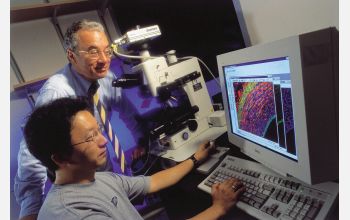Multimedia Gallery
Using organ culture system to understand cells
Ray Vito, a professor at the Georgia Institute of Technology School of Mechanical Engineering, and graduate student Yu Shin Kim (foreground) are using an organ culture system designed at Georgia Tech as a testbed for understanding the mechanical environment of cells. Ultimately, researchers will use information from these studies to establish a rational basis for tissue-engineered design.
This ongoing research on tissue engineering is taking place at the Georgia Tech/Emory Center for the Engineering of Living Tissues (GTEC), a National Science Foundation (NSF) Engineering Research Center. Created in 1998, GTEC is supported by NSF and matching grants from the institutions and the Georgia Research Alliance.
Many people volunteer to donate organs, however, the large demand for organs and the technology to store them have combined to create a crisis and thousands of patients die every year waiting for compatible organ donations. The tissue engineers at GTEC are working hard to create living tissue and organ substitutes that can be used in place of human organ donations. (Year of image: 2000)
Credit: Photo by Gary Meek
Images and other media in the National Science Foundation Multimedia Gallery are available for use in print and electronic material by NSF employees, members of the media, university staff, teachers and the general public. All media in the gallery are intended for personal, educational and nonprofit/non-commercial use only.
Images credited to the National Science Foundation, a federal agency, are in the public domain. The images were created by employees of the United States Government as part of their official duties or prepared by contractors as "works for hire" for NSF. You may freely use NSF-credited images and, at your discretion, credit NSF with a "Courtesy: National Science Foundation" notation.
Additional information about general usage can be found in Conditions.
Also Available:
Download the high-resolution TIFF version of the image. (2.7 MB)
Use your mouse to right-click (Mac users may need to Ctrl-click) the link above and choose the option that will save the file or target to your computer.



